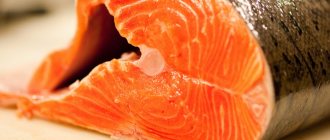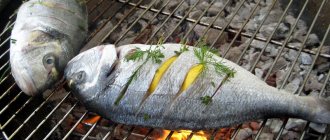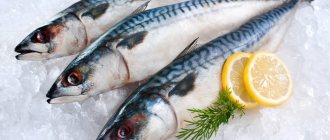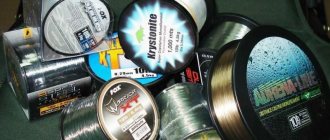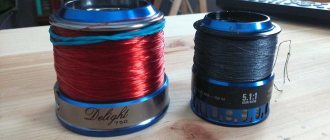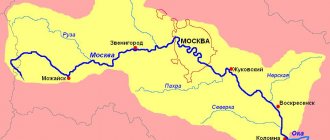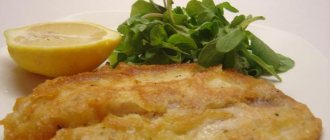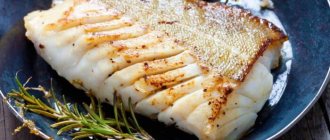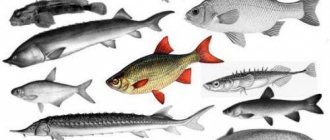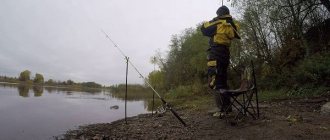Author Anna Smirnova
05/08/2020 10:59 (Updated: 05/08/2020 12:43)
Health » Health and prevention » Diet
Fish is one of the most delicious and healthy foods in the diet. Even for those who don’t particularly like the inhabitants of water on their table, you can always choose an option.
- By the way, the statement that healthy fish is an expensive pleasure is completely false.
As a rule, people who say this consider only salmon or sturgeon to be fish.
But in fact, there are enough types of fish that will not burden the budget and will become a real feast of taste and health.
Mackerel
This is another old friend.
- In terms of useful substances, mackerel is almost no different from herring, and besides, it contains large doses of fluoride, which is responsible for dental health.
Of course, you shouldn’t eat smoked mackerel often - this product will do nothing but harm, but baked in the oven or on the grill is practically a delicacy!
By the way, an interesting fact:
- Mackerel is one of the most widely fished fish species in the world. There are only pollock, tuna and herring from the Atlantic ahead. And in the very first place is the Peruvian anchovy
Whiting and silver hake
Currently, hake and hake are sold as a variety of fish. In fact, this is the same fish, but in France, Spain, Africa and South America it is called hake, and in Canada, the USA and England it is called hake.
The hake, or hake, has two dorsal fins and one anal fin. At the posterior ends of the second dorsal and anal fins there are longer rays that form a kind of elevation; there are no antennae on the chin. The scaly skin varies from yellowish-silver, gray or brown to very dark shades. The length of the fish, depending on the fishing areas, can be from 17 to 90 cm.
The meat of hake is white, tender, with a good aroma and taste - better than that of cod. It contains slightly more fat than cod meat (an average of 2.6%). Less waste than cod. The fat content of the liver is about 44%. The caviar of this fish is a valuable food product; it contains on average 7.2% fat and 19% protein. Hake, or hake, can be boiled, fried, or made into aspic.
Hake meat is tastier, since hake has better feeding grounds than hake.
The benefits of pollock
Pollock, from the cod family, is caught mainly in the cold waters of the Pacific Ocean and, in terms of production volumes, ranks first in comparison with other cod fish, including hake. In the area of the Kuril ridge, Sakhalin Island, and the Far East, pollock is considered not only tasty, but light and healthy food . Due to its availability, every family loves this fish and knows how to cook it properly.
The nutritional value
Pollock fish is rich not only in nutritional composition, but also in a large number of microelements and vitamins . It contains quite a lot of proteins, fats and almost no carbohydrates.
- There is little fat, only 0.9 g per 100 g of product, which makes fish useful in diets.
- There is quite a lot of protein of animal origin, about 15.9 g per 100 g , which is 500 g, which is the daily requirement for an adult.
- Among the vitamins there are “A”, “E”, group “B” , especially “B12” .
- Vitamin PP , nicotinic acid, involved in the formation of enzymes in living cells.
- There are a large number of macroelements in pollock, providing up to 30% phosphorus, potassium and magnesium in 100 g of pulp. And also 100% iodine, 150% cobalt and 110% chromium.
- Omega-3 unsaturated fatty acids provide about 20% of the norm.
- Pollock is famous for its low calorie content of 70 kcal per 100 g .
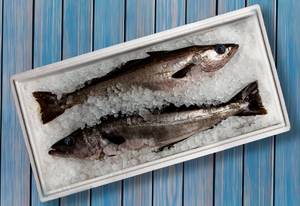
The benefits of pollock for the body
Pollock has great nutritional value:
- It is recommended to be used in all therapeutic and health diets; it satisfies the body with its rich chemical composition and does not cause a feeling of hunger .
- The composition of micro and macroelements is beneficial for tooth enamel, ensures hair growth, and improves skin condition.
- Pollock is recommended to be included in the diet for many diseases , such as endocrine system failure, diabetes, diseases of the cardiovascular system , and housing and communal services diseases.
- For people who lack iodine , it is recommended to eat it regularly.
- For those who are obese , pollock is useful as a low-calorie product.
Mackerel family - photos, names
The family includes ray-finned fish, which are characterized by:
- additional fins behind the anal and soft dorsal fins;
- laterally compressed thin caudal peduncle with 2 or 3 keels;
- fusiform long body;
- bony ring around the eyes.
The names of the fast swimmers of this marine family include: tuna, marel, sard, bonito, wahoo, Azov-Black Sea, Atlantic, Kuril and Far Eastern mackerel. Their meat usually does not have small bones, but is quite fatty and tender. It contains a lot of vitamins D and B12, as well as omega-3 acids.
Delicious navaga
Navaga belongs to the Cod family. It also looks like small cod. The fish lives in the Barents, White and Kara seas - and it was this fish that young Mikhailo Lomonosov caught along with cod and white-sea herring. This fish is the basis of the diet of Pomors. Navaga was frozen freshly caught (usually still alive) and sold by cartload to Novgorod and Moscow. The story of how 19-year-old Mikhailo accompanied a convoy of fish to Moscow, and there, captivated by the capital’s temptations, and stayed, has long become a textbook story.
You can dry navaga, but I warn you - it most likely won’t turn out to be a delicacy: navaga is covered with mucus, the specific aroma of which will remain in dried fish. Therefore, it is best to simply fry the navaga. And freshly caught navaga makes a good rich fish soup.
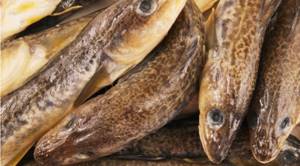
Freshly caught navaga
When buying frozen navaga, we look at the number of curved carcasses: the more, the better. This means that the fish moved before falling asleep, that is, it was frozen alive. The skin should be tight, not flabby and not wrinkled - this is a kind of sign “the fish was not defrosted during storage.” Well, the abdomen should not be sunken or sagging. Fish should be purchased, if possible, ungutted and with the head on: when cutting and storing, cut and headless navaga inevitably loses some of its juice.
By the way, I’m telling all this about northern navaga. And we also have vakhnya on sale - Far Eastern or Pacific navaga. It is noticeably larger, but its taste is a little simpler and coarser.
Wash the thawed navaga thoroughly under running cold water. I usually recommend avoiding contact of fish with water unless we are going to cook it, but navaga is a special case. As I said, mucus, which improves the taste of fish soup (fat), when cooking fish soup (then ordinary freshwater fish is not washed), but the mucus of fish for frying must be removed. We gut the washed fish, discard the gills, and wipe the carcasses with a paper towel.
Pour vegetable oil into a large frying pan and heat it up. I fry the fish in a frying pan with a ceramic coating, so a minimum of oil is required, and I don’t use flour, eggs, breadcrumbs and other tricks at all. Season with salt and freshly ground black pepper. Fry for about 4-5 minutes on one side.
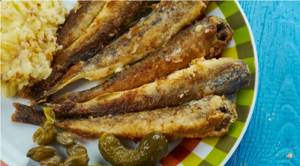
Fried navaga
How to select and store
On sale you can find chilled and frozen fish, presented whole and sliced, with or without heads.
When buying fresh hake you should pay attention to:
- gills, which should be red rather than pale gray or dark;
- the surface of the carcass, which must be moist, clean and smooth, without spots of a different color, growths or mechanical damage;
- a smell that should be pleasantly fishy without a hint of algae or chemicals;
- surface color, which should be uniform;
- structure, which should be dense;
- eyes, which should be clear and gaze directed forward.
When choosing frozen fish, you should pay attention to:
- ice crust, which should be thin, without large growths, and the ice should be clean, without traces of bruises;
- the shape of the fish, which should be natural, without a strangely curved tail or body;
- the surface of the carcass, which must be intact, without damage or shades of a different color;
- weight that must correspond to the size (if the carcass is too light, then it was frozen a long time ago; if it is too heavy, then it was re-frozen).
If the meat of sliced fish has acquired a yellowish tint, this means that the oxidation process has begun. In this case, you should refuse to purchase the product.
After purchasing fresh fish, it is recommended to start cooking on the same day so that the carcass does not lose its characteristic aroma and taste. Cleaned and washed fish can be stored in the refrigerator for 24 hours, but always separately from other products and in packaging that “breathes.”
If cooking is not expected soon, then the carcass should be cleaned of entrails and dirt and frozen. Hake can be stored in the freezer for six months.
To choose a high-quality hake, you should be careful.
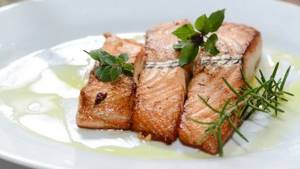
The flesh of fresh fish is more elastic when pressed, so after a while the dent on its surface becomes invisible; in fish with a long shelf life, looseness is observed; when pressed, the meat remains pressed in and can be sticky to the touch.
The freshness of hake can also be determined by its smell - it should have a pleasant fishy aroma, and not give off unknown chemical compounds or not smell at all. In the latter case, this may also indicate that dangerous chemicals were used to preserve the fish, neutralizing the natural aroma of the fish.
If the frozen hake is too light in weight, this may mean that it has been frozen for a long time and during this time has had time to “dry out”. There are almost no beneficial properties left in such fish.
The buyer should also be wary of an excessive amount of ice glaze around the hake carcass; this is evidence of re-freezing or an attempt to disguise its real shelf life.
Since hake in its raw form quickly loses its valuable qualities, it is preserved by “shock” freezing, that is, by quickly reducing the temperature to -18-240. At home, it should be stored in the freezer and under no circumstances should it be re-frozen.
The benefits of hake
Deep-sea hake is caught in the waters of the Pacific and Atlantic Oceans in many countries around the world and in Russia. The caught fish is processed immediately at the fishing base so that it does not lose its aroma and taste properties . This ensures that all the beneficial nutritional properties of hake are preserved.
The nutritional value
Hake, like an oceanic cod fish, is quite large in size, up to 70 cm and weighing up to 3 kg . Rich in all mini and macro minerals and vitamins important for the human body. The useful components include:
- In the ratio per 100 g of hake pulp contains: proteins about 16.6 or 11%, fats about 2.2 g or 5%, carbohydrates 0%, dietary fiber 0%.
- Calorie content per 100 g of pulp is only 86 kcal .
- 100 g of hake pulp contains micro- and macroelements: Magnesium (9%), Sodium (3%), Potassium (10%), Iron (4%), Phosphorus (24%), Zinc (6%).
- One 100 g serving of hake contains B vitamins: B6 (5%). B12 (40%), also D (8%), PP (7%), A (4%) and E (8%).
- The composition includes beneficial monounsaturated fatty acids , which are not produced by the body itself.
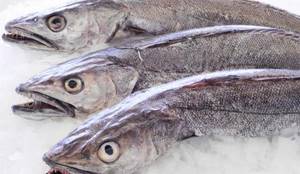
The benefits of hake for the body
When frozen, hake retains its beneficial properties as much as possible, such as:
- Hake, as a gentle, soft product, normalizes digestion and neutralizes and removes carcinogenic components in the body.
- The antioxidants contained in fish pulp have a great therapeutic effect on the heart and blood vessels
- It is useful to eat hake, which contains Omega 3, iodine, to regulate the functioning of the thyroid gland, as well as to improve the condition of the skin and hair growth.
- It has a noticeable positive effect on depression and nervous disorders, strengthens the immune system .
- If you have diabetes, hake dishes will help you follow a strict diet . It has been observed that fish lowers blood sugar.
Delicious capelin
Capelin belongs to the Smelt family.
buy capelin in a frozen piece, broken from a briquette, and not in bulk - this way there is a greater likelihood that the fish has not yet been defrosted after being caught. And don't be afraid to buy big pieces - I'll tell you what to do with them.
Let's take a piece of 4 kilograms. We salt some and fry some. First we do the salting: we salt the fish while it’s frozen. The explanation for this is simple: salt, and even through the skin, penetrates the muscles of the fish gradually, and warm fish spoils from the inside faster and the salt will not have time to save it. So we salt the frozen capelin, which barely separates from a large piece.
Place our piece in a tray and let it thaw a little at room temperature. It is necessary that the fish begin to separate from each other and nothing more. We do not tear them off with force, so as not to damage the skin, but you can carefully pull out the thawed ones from the overall piece. In this case, the piece itself will still be quite frozen inside.
We do not gut or wash the separated fish. We sort through, discarding crushed and flabby specimens: the fish should be elastic. If you have a favorite soy or oyster sauce, drop a little on a couple of fish and try frozen and unsalted capelin with sauce - this is an interesting gastronomic experience, but the taste is not for everyone!
Sprinkle “Extra” salt thinly onto the bottom of a container (glass, plastic or stainless steel). We lay the capelin in layers, always sprinkling with the finest salt. The capelin is salted for 24 hours, and during this time the coarse salt crystals do not even have time to dissolve. If the area of the container allows, we lay the layers crosswise. We don’t put oppression on top. Place the container in the refrigerator for 12-24 hours. During this time, the capelin will be defrosted and salted. Determine the salting time yourself; some people like the fish saltier, while others like it lightly salted.
After 24 hours, the fish defrosted, settled, and the layers became denser. If there is some salt left on the fish, quickly rinse it under running cold water.
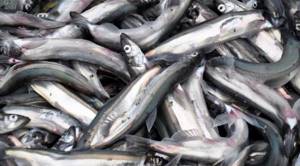
Fresh capelin
They eat capelin by grabbing the head with two fingers and carefully eating the meat from the spine, starting from the tail. You can act more culturally: put the fish on a plate, remove the meat from the ridge with the side tine of a fork, remove the intestines and the black membrane of the abdominal cavity (it is bitter!) - eat and enjoy the pure taste of the fish. You can also put the fillet on white bread with butter - delicious!
The capelin will be lightly salted for another 2-3 days, and then it will begin to become coarse and over-salty. Therefore, part of the fish can be hung on a wire or string, threading straightened paper clips through the eye sockets, and dried. Capelin is a fatty fish. It will drip: don’t forget to put a tray under the fish! To make it drip less, hang it upside down. Let it hang for about 5-6 days, so it will not be dried, but hung. The meat will remain soft, and the carcass itself will become quite dense. If you lift it with two fingers, the fish will remain straight. Those who like drier fish leave capelin to hang longer. On the 5-6th day, spring capelin has a completely different taste compared to “wet” lightly salted capelin, as if they were different types of fish. On day 10-11, the fish is already dried.
Yes, we still have some capelin left for frying. Fry the defrosted fish in vegetable oil in a very hot frying pan. If the pan has a good non-stick coating, you can fry without flour. Fry quickly so as not to dry it out!
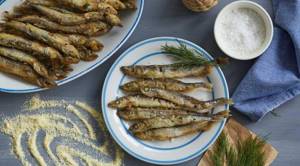
Capelin fried in cornmeal
Capelin recipes
Capelin can also be smoked and used for filling pies and pies. We recommend preparing capelin in cheese tempura with country-style potatoes , galette with capelin , fried capelin with tomatoes , sandwich with fried capelin , capelin baked in the oven and, of course, fried capelin breaded in corn flour .
Types of white fish
White fish that live in the seas have a specific white color. However, it has differences:
- in appearance (flat, round); by belonging to a particular family.
Flat fish include:
Round fish include:
- pollock haddock hake cod pollock striped bass burbot monkfish red snapper
This fish has a very original appearance due to its flattened shape.
The main bones, diverging from the back, look like rays directed towards both sides of the ridge.
Flat fish can grow to gigantic sizes, reaching a length of up to 2 meters.
Where does it live, what does it eat?
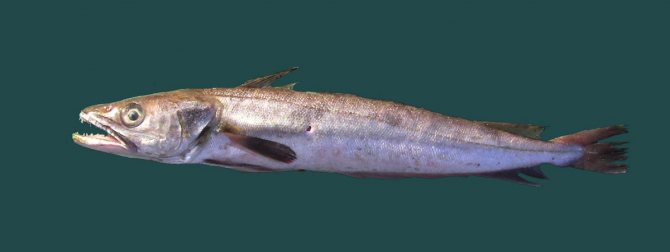
The hake fish has access to the entire world ocean with its numerous seas and bays, but it still prefers to stay close to the continental shelves. The adult marine specimen is found in deep waters (from 100 to 1000 m) of the Pacific and Atlantic oceans, and each species has its own range:
- Silver whiting stays off the Atlantic coast of North America on the shelf from the Bahamas to the Strait of Belle Isle. The largest catches occur in the region between southern Newfoundland and South Carolina.
- The range of the Pacific hake covers the northeastern Pacific Ocean from Vancouver Island to the Gulf of California.
- Argentine hake lives in the coastal zone of the Atlantic Ocean in South America - from Brazil to the Falkland Islands.
- Cape hake is found off the coast of Angola and South Africa.
- The New Zealand hake is also named for its habitat off the coast of New Zealand and Patagonia.
- Chilean hake is the main commercial fish of Chile and Peru, located on the Atlantic coast of South America.
The hake spends most of the day at depth (therefore it can only be caught with a bottom trawl), and at night it rises from the bottom to feed.
Despite the fact that hake live in sea water, young individuals sometimes enter the mouths of rivers flowing into the sea, moving slightly up the river current.
This is due to the search for easy prey in river waters. In the sea they feed on plankton and small crustaceans, and when they mature, they turn into predators and begin to hunt small fish, squid and schooling fish - sardines, mackerel, herring. Sometimes large individuals eat small ones, which indicates the presence of cannibalism in the hake population.
Herring fish - names, photos
Marine fish of this species are distinguished by the fact that they do not have a single scale on their heads . They have very small teeth and no or very short lateral line. The most important commercial species of herring are:
- European sprat;
- European sardine;
- Pacific herring;
- Atlantic herring;
- Atlantic menhaden.
Sea herring meat has a large amount of protein, polyunsaturated fats, and vitamin A.
Round inhabitants of reservoirs
Many people wonder how round fish differs from flat fish. The name here speaks for itself. Round fish are characterized by a rounded body shape, while it is slightly thickened. Her eyes are located on both sides of her head. It is characterized by the curved shape of the rib bones, which go down from the ridge.
The following types of fish are classified as round:
- angler,
- striped bass,
- red snapper,
- haddock,
- nelma,
- burbot,
- hake,
- cod.
The most common of these types are the following:
- Cod. This family has a certain number of subspecies. Some individuals reach a length of about 1.7 m, while others do not grow up to 1 m. Cod is a valuable commercial fish species, which is found mainly in the northern parts of the Atlantic and Pacific oceans. They are characterized by high fertility and a gregarious lifestyle. Of particular value are individuals aged from 3 to 7 years, weighing about 10 kg. A very interesting fact is that some specimens live up to 100 years and are famous for their gigantic size.
- Nelma. Also belongs to the order of freshwater fish, it is characterized by a silvery tint. Nelma is quite large: its weight sometimes reaches 50 kg, and its length is up to 1.5 m. It feeds on smaller fish, such as smelt and vendace. Spawning of nelma occurs in the fall. Its fertility is quite high and can amount to up to 400 thousand eggs.
- Haddock. It is one of the varieties of valuable commercial fish. Its annual catch is produced in huge quantities - more than 500 thousand tons. Lives in the depths of the Atlantic and Arctic oceans. It reaches a weight of 20−30 kg, but most caught individuals weigh no more than 15 kg. It differs from other species by its specific oval-shaped black spots on both sides of the head. According to experts, they recognize their relatives by the presence of these characteristic spots. It can often be found on sale in grocery and fish stores, and its lean meat is recommended for consumption by nutritionists.
- Burbot is similar in appearance to catfish and lives in fresh waters. Found in Europe and Asia. Preference is given to cool water, with temperatures not exceeding +25°C. Lives in close proximity to the bottom. During the hot summer period, when the water temperature exceeds the optimal temperature regime, burbot hides under snags and in burrows until cold weather arrives. He prefers to “hunt” at night, so it is at this time of day that it is best to catch burbot, using spoons, lures, and bottom tackle.
- Hake, as a representative of the cod species, loves salt water and lives shallow. Most often, individuals are found with a length of about 40−50 cm, but some specimens reach 1.5 meters in length. Hake deserves to take an honorable first place among cod fish, thanks to the excellent taste of the meat. Nutritionists also recommend consuming it, because hake meat contains a large amount of vitamins and is low-fat.
- Striped bass also has high characteristics in all respects. Spawns in the Atlantic Ocean, where low water temperatures prevail. It is also found in the Sea of Azov. It is classified as a predator and is usually caught by sports fishermen: catching a perch is not so easy. Its characteristic features are unpredictability of behavior and rapid movement along the water surface, which greatly complicates catching, which, in turn, requires careful preparation and special detection equipment, such as an echo sounder. Interestingly, the largest specimen caught weighed 37 kg.
- Monkfish also has another name - “European anglerfish”. It lives at a depth of two hundred meters, its lifestyle is sedentary. Can reach very large sizes. It has a large, flattened head, occupying almost two-thirds of its body. Found in the waters of the Atlantic Ocean, in the Barents and Black Seas, it feeds on small fish. Despite its unattractive appearance, monkfish has excellent taste.
